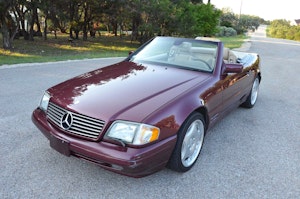Media | Articles
Buyer beware: There are more rebodied cars out there than you think
It was the eBay auction title that got me: “1969 Ford Mustang SHELBY GT350.” That attention-grabbing ALL CAPS was likely no accident. This was indeed a 1969 GT350, parked behind a barn, with a large tree that had grown up and around the rear bumper. Other photos showed the GT350 relocated to a parking lot and sitting on logs. It had no front clip and little front suspension, the result of the 1973 crash described in the write-up. Living outside ever since hasn’t helped matters.
This car started life as a Silver Jade GT350 fastback with a four-speed. The original engine was included, its oil pan rusted through from lying in the dirt beside the car. The front fender aprons, a critical part since they carry the Ford VIN, were junk. The transmission was gone, the roof caved in. Everything else was rusted away. The VIN tag, the original spare tire, and the Marti report were the best this poor car had to offer. At the end of the auction, the “car” sold for $28,900.
The value of a great 1969 GT350 is about $100,000. The restoration to take this hulk to that level could easily cost $150,000, yet its final value would be diminished by the fact that it was wrecked and rusted and would be comprised of almost all replacement parts. That equation brings us to a dirty little secret of the hobby: rebodied, or “air” cars, built from little more than legal ownership and (usually) the earthly remains of desirable cars.

For this GT350, the correct—and hardest—thing would be a costly restoration entailing thousands of hours of labor and an extensive list of hard-to-find original parts. If it retains its original cowl with an undisturbed VIN tag and as much of its original metal as possible, it could still rightly be claimed as the same car it has always been. I hope this labor of love happens.
Marketplace
Buy and sell classics with confidence
But many cars like this GT350 get restored the wrong way. Quite simply, this involves taking the original VIN and other identifiers, throwing out the rusty carcass, and swapping those numbers to a rust-free 1969 Mustang shell. Often, a cheaper coupe might be used, with the original GT350 fastback roof grafted on. This is illegal—removing a VIN and replacing it with another—and usually has its roots in a clear intent to defraud for profit.
The number of these rebodied cars circulating the hobby is greater than you’d think. Most eventually get outed, but not all. I’ve inspected plenty of cars, only to discover a body swap. One common example: All 1965 and ’66 Shelby GT350s were built using a shell from Ford’s San Jose plant. They are unique compared to shells built elsewhere. But people have used these incorrect shells to rebody GT350s, a tactic easily spotted by anyone who knows what to look for. Similar telltale signs exist for domestics, and for European cars, too.

But what if a rebody is properly disclosed? What does that mean for value? Recently, a 1969 Yenko Camaro came up for auction. The description said it had extensive original paperwork, was listed in the Yenko Supercar Registry, and had won many of the right shows. But then there was that last line: “Car has been rebodied.” A pure 1969 Yenko Camaro in great shape would have sold for $250,000 or better. This one sold for $99,000—close to Yenko clone money. Plenty of people might consider this car a clone; you could argue that it is, if the real Yenko identity were to be removed.
The best way to protect yourself from these shenanigans is to buy cars with documented history, and it pays to hire an expert intimately familiar with the type of car you want. To me, the “soul” of the car gets chipped away with every year it is MIA and with every part replaced. This is one reason the value of a great original, unrestored car could eclipse that of a similar car restored to a concours level. Originality and known history eliminate any concern of a rebody.
As for this eBay GT350, I already have the VIN in my notes. I can’t wait to see if, or when, it pops up again—and in what condition. Sometimes they come back, but not always as they should.
20181004172256)
20181004172242)









